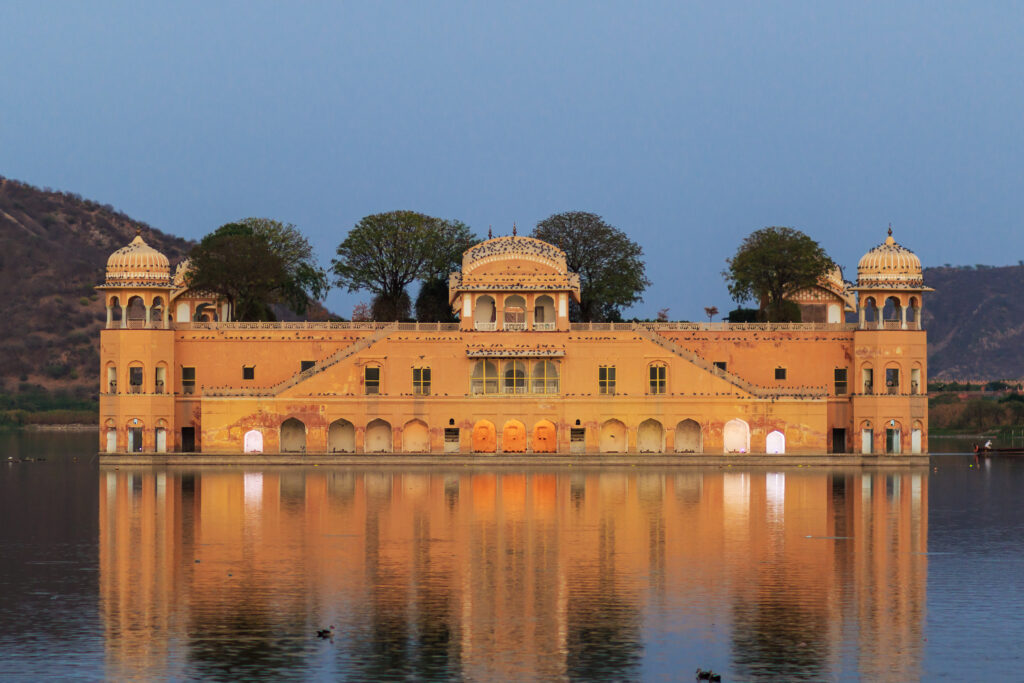Nestled in the heart of Jaipur, Rajasthan, the Jal Mahal, or Water Palace, stands as a stunning testament to the architectural brilliance of the Mughal era. This enchanting palace, partially submerged in the waters of Man Sagar Lake, has captivated visitors for centuries with its serene beauty and intriguing history. As we explore the secrets of the Jal Mahal, we will uncover its unique design, historical significance, and the myths that surround this mesmerizing structure.

A Glimpse into History
Constructed in the 18th century by Maharaja Sawai Jai Singh II, the founder of Jaipur, Jal Mahal was originally built as a retreat for the royal family. The palace served as a summer getaway where they could enjoy boating and relaxation away from the heat of the city. Designed in the Rajput style, the architecture reflects a harmonious blend of Mughal and Rajput influences, characterized by intricate carvings, beautiful courtyards, and expansive balconies overlooking the lake.
Over the years, Jal Mahal has faced numerous challenges, including flooding and neglect. However, recent restoration efforts have breathed new life into the palace, making it a popular tourist destination. Today, visitors can admire its stunning façade and the picturesque backdrop of the Aravalli hills.
Architectural Marvel
One of the most striking features of Jal Mahal is its unique architectural design. The palace is built with red sandstone, adorned with delicate lattice work, intricate jali screens, and beautiful chhatris (domed pavilions). The design cleverly incorporates the surrounding environment, making it appear as though the palace rises from the water itself.
The structure consists of five floors, three of which remain submerged beneath the surface of the lake. This innovative design allows for natural cooling, a crucial feature in the sweltering Rajasthani summers. The upper floors offer breathtaking views of the lake and the surrounding hills, making it an ideal retreat for the royal family.

Legends and Myths
Jal Mahal is steeped in legends and myths that add to its allure. One popular tale speaks of a hidden treasure believed to be buried within the palace. According to local folklore, a mystical prince once ruled over the area and hid his riches in the palace to protect them from invaders. While no treasure has ever been found, the story continues to capture the imagination of locals and tourists alike.
Another fascinating myth involves the lake itself. It is said that the lake was once home to a powerful spirit who guarded its waters. Legend has it that the spirit would bless those who treated the lake with respect and punish those who polluted it. This belief has fostered a sense of reverence for the lake and its surroundings, prompting conservation efforts to maintain the area’s natural beauty.
The Surrounding Environment
Jal Mahal is set against the picturesque backdrop of Man Sagar Lake, which adds to its charm. The lake is not only a visual delight but also an ecological haven, home to various bird species, including migratory birds during the winter months. Birdwatchers and nature enthusiasts flock to the area, hoping to catch a glimpse of these avian wonders.
In addition to its natural beauty, the lake offers recreational opportunities such as boating and picnicking. Visitors can rent paddle boats and explore the tranquil waters, providing a unique perspective of the palace and its surroundings. The experience of gliding across the lake while taking in the stunning architecture of Jal Mahal is truly unforgettable.
A Cultural Icon
Today, Jal Mahal stands not only as a historical monument but also as a symbol of Jaipur’s rich cultural heritage. It is a popular spot for photography, attracting couples, families, and solo travelers eager to capture the palace’s ethereal beauty. The site often hosts cultural events and festivals, showcasing local art, music, and cuisine, further immersing visitors in the vibrant culture of Rajasthan.
As the sun sets, the palace is illuminated, casting a magical glow on the water. This enchanting sight is a must-see for anyone visiting Jaipur, offering a perfect end to a day of exploration.

Conclusion
Jal Mahal, with its captivating history, stunning architecture, and the enchanting tales that surround it, is a true gem of Rajasthan. Whether you’re a history enthusiast, a nature lover, or simply seeking a moment of tranquility, the Water Palace promises an unforgettable experience. As you stroll along the shores of Man Sagar Lake, take a moment to appreciate the secrets held within this magnificent palace—a place where the past and present converge in perfect harmony.

